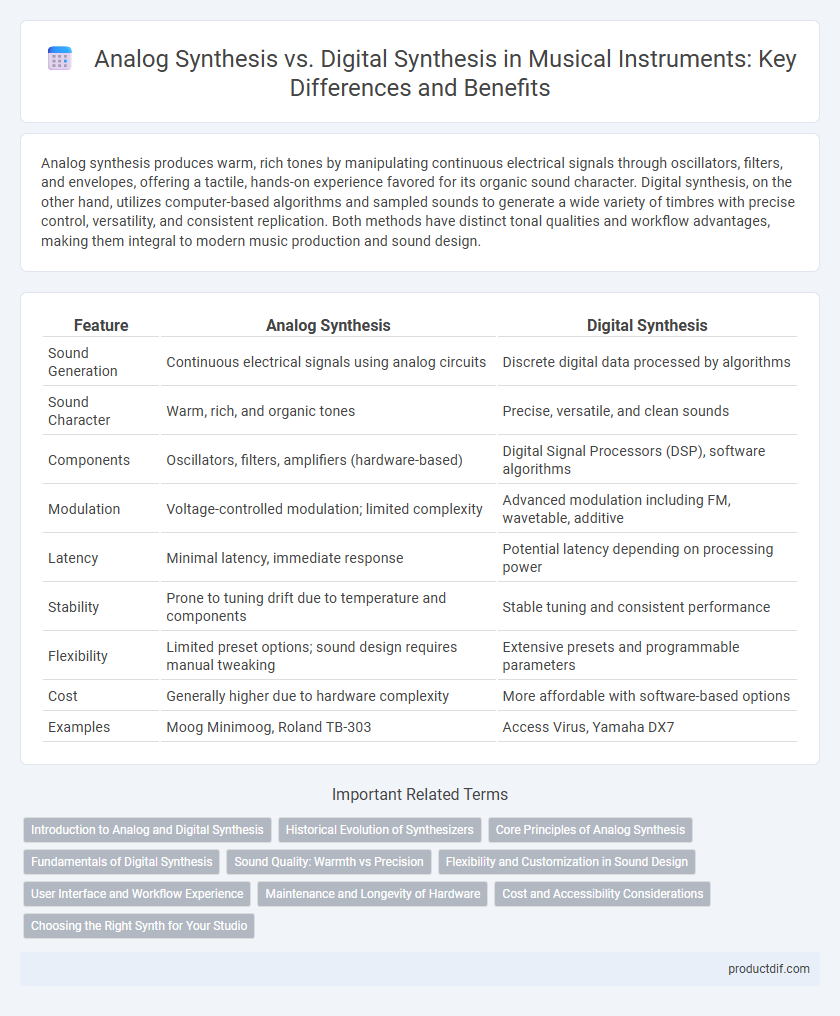Analog synthesis produces warm, rich tones by manipulating continuous electrical signals through oscillators, filters, and envelopes, offering a tactile, hands-on experience favored for its organic sound character. Digital synthesis, on the other hand, utilizes computer-based algorithms and sampled sounds to generate a wide variety of timbres with precise control, versatility, and consistent replication. Both methods have distinct tonal qualities and workflow advantages, making them integral to modern music production and sound design.
Table of Comparison
| Feature | Analog Synthesis | Digital Synthesis |
|---|---|---|
| Sound Generation | Continuous electrical signals using analog circuits | Discrete digital data processed by algorithms |
| Sound Character | Warm, rich, and organic tones | Precise, versatile, and clean sounds |
| Components | Oscillators, filters, amplifiers (hardware-based) | Digital Signal Processors (DSP), software algorithms |
| Modulation | Voltage-controlled modulation; limited complexity | Advanced modulation including FM, wavetable, additive |
| Latency | Minimal latency, immediate response | Potential latency depending on processing power |
| Stability | Prone to tuning drift due to temperature and components | Stable tuning and consistent performance |
| Flexibility | Limited preset options; sound design requires manual tweaking | Extensive presets and programmable parameters |
| Cost | Generally higher due to hardware complexity | More affordable with software-based options |
| Examples | Moog Minimoog, Roland TB-303 | Access Virus, Yamaha DX7 |
Introduction to Analog and Digital Synthesis
Analog synthesis generates sound through continuous electrical signals using voltage-controlled oscillators, filters, and amplifiers, offering warm and rich tones favored in classic synthesizers. Digital synthesis creates sound by processing digital data via algorithms and samples, enabling versatile sound design, precise control, and integration with modern music production software. Both synthesis types form the foundation of electronic music, with analog praised for its organic character and digital valued for its flexibility and expansion capabilities.
Historical Evolution of Synthesizers
Analog synthesis emerged in the 1960s with pioneering instruments like the Moog Modular and ARP 2600, utilizing voltage-controlled oscillators and filters to create warm, rich tones directly through electrical circuits. Digital synthesis gained prominence in the 1980s with the introduction of the Yamaha DX7, leveraging digital signal processing and frequency modulation to produce versatile and complex sounds with greater stability and programmability. The historical evolution of synthesizers reflects a transition from purely analog hardware generating sounds through continuous electrical signals to sophisticated digital systems enabling precise, reproducible, and diverse sonic textures.
Core Principles of Analog Synthesis
Analog synthesis generates sound through continuous voltage variations controlling oscillators, filters, and amplifiers, producing rich and warm tones valued by musicians and sound designers. Core principles include voltage-controlled oscillators (VCOs) that create raw waveforms, voltage-controlled filters (VCFs) shaping harmonic content, and voltage-controlled amplifiers (VCAs) managing amplitude dynamics in real-time. This tactile interaction with hardware components offers a distinct, organic sound character often preferred over the precision and versatility of digital synthesis methods.
Fundamentals of Digital Synthesis
Digital synthesis generates sound by processing numerical data through algorithms, enabling precise control over waveforms and modulation parameters. Techniques such as additive, subtractive, frequency modulation (FM), and wavetable synthesis allow for complex and diverse sound design not easily achievable with analog methods. Digital synthesizers leverage microprocessors and DSP (digital signal processing) chips, offering stability, patch recall, and integration with MIDI systems for enhanced performance versatility.
Sound Quality: Warmth vs Precision
Analog synthesis produces sound with rich harmonic warmth and natural imperfections, creating a lush, organic texture favored in vintage and classic music production. Digital synthesis offers precise control over sound parameters, enabling clear, consistent tones ideal for intricate and modern sound design. The choice between analog warmth and digital precision largely depends on the desired sonic character and application in musical styles.
Flexibility and Customization in Sound Design
Analog synthesis offers unique warmth and organic variability due to its voltage-controlled oscillators and filters, ideal for musicians seeking hands-on modulation and distinct tonal character. Digital synthesis provides extensive flexibility through complex algorithms, precise parameter control, and the ability to store and recall presets, enabling intricate sound design and rapid experimentation. Hybrid synthesizers combine analog warmth with digital versatility, maximizing customization options in modern music production.
User Interface and Workflow Experience
Analog synthesis offers tactile control with dedicated knobs and sliders for each parameter, providing an intuitive and immediate user interface that encourages hands-on experimentation. Digital synthesis often features menu-driven interfaces and software integration, allowing for complex sound design but sometimes leading to a steeper learning curve and less direct manipulation. Workflow experience in analog systems emphasizes real-time adjustments and organic sound shaping, while digital systems enable extensive editing, presets, and automation options suited for detailed programming and recall.
Maintenance and Longevity of Hardware
Analog synthesizers often require regular maintenance due to their reliance on physical components like capacitors and potentiometers, which can degrade or drift over time, impacting sound quality and stability. Digital synthesizers typically benefit from increased durability and lower upkeep since they use software algorithms and solid-state components less prone to wear. However, the longevity of digital instruments depends on software support and hardware compatibility, which can become obsolete without updates.
Cost and Accessibility Considerations
Analog synthesis instruments generally feature higher manufacturing costs due to complex circuitry and vintage components, leading to elevated prices that may limit accessibility for beginners. Digital synthesis leverages software and modern hardware, significantly reducing production expenses and offering more affordable options without compromising sound versatility. Budget-conscious musicians often prefer digital synthesizers, benefiting from a wide range of cost-effective and easily accessible models.
Choosing the Right Synth for Your Studio
Analog synthesis produces warm, rich tones through voltage-controlled oscillators and filters, ideal for musicians seeking classic sounds with organic character. Digital synthesis offers versatility and precision, enabling complex waveforms, extensive modulation, and cost-effective solutions perfect for modern studio setups. Selecting the right synth depends on desired sound texture, workflow preferences, and budget constraints.
Analog Synthesis vs Digital Synthesis Infographic

 productdif.com
productdif.com